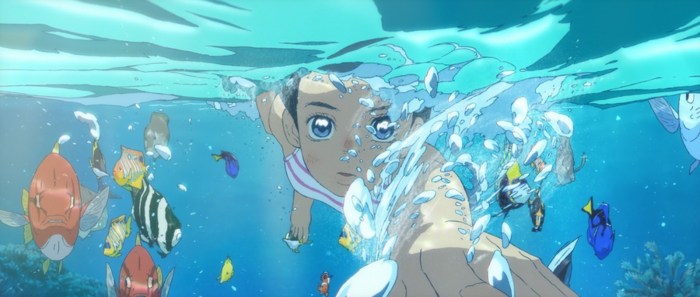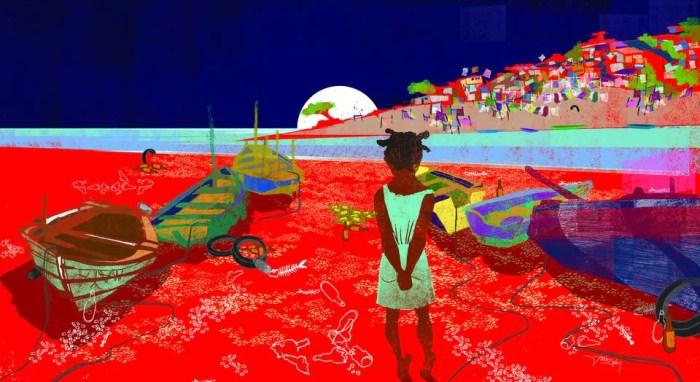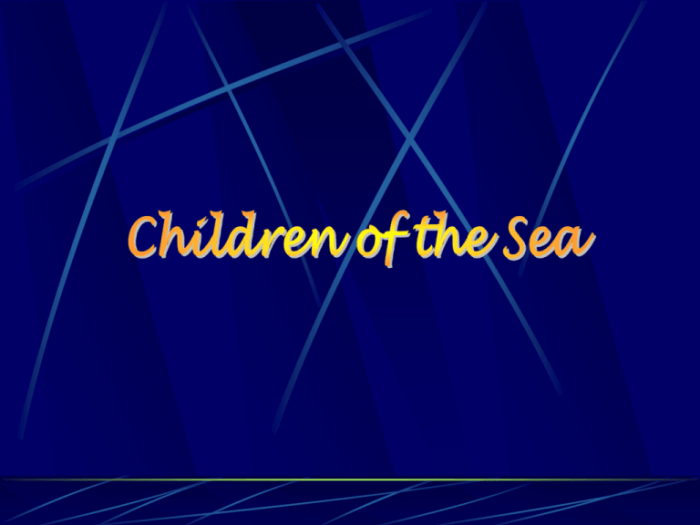Children of the sea edwidge danticat – Children of the Sea by Edwidge Danticat is a captivating novel that delves into the profound experiences of immigration, displacement, and the search for identity. Through its rich narrative and evocative prose, Danticat paints a vivid portrait of the Haitian diaspora, exploring the complexities of belonging and the enduring power of the human spirit.
The novel follows the journey of a young Haitian woman named Ifemelu as she navigates the challenges of life in the United States. As she grapples with the complexities of her new surroundings, Ifemelu’s story becomes a poignant exploration of the multifaceted nature of identity and the universal desire for connection.
Authorial Perspective
Edwidge Danticat’s experiences as a Haitian-American woman, an immigrant, and a mother deeply influenced her writing of “Children of the Sea.” Her own family’s journey from Haiti to the United States and the struggles they faced along the way provided her with firsthand insights into the challenges and triumphs of displacement and cultural assimilation.
Purpose and Intended Audience
Danticat’s purpose in writing “Children of the Sea” was to shed light on the plight of Haitian refugees and to explore the complex themes of identity, family, and belonging. She intended the novel to resonate with readers of all backgrounds, particularly those who have experienced displacement or have been affected by migration.
Historical and Cultural Context

Children of the Sea is set against the backdrop of the Haitian diaspora and explores the themes of immigration, displacement, and identity within this context.
Historical Events
The novel is set in the aftermath of the Haitian Revolution, a period marked by political instability and violence. This turmoil led to the displacement of many Haitians, who fled to other countries in the Caribbean and beyond.
Cultural Influences
The Haitian diaspora has had a profound impact on the novel’s characters and setting. The characters’ experiences reflect the challenges and triumphs of immigrants and refugees, as they navigate new cultures and identities while maintaining ties to their homeland.
Character Analysis
The novel “Children of the Sea” features a cast of compelling characters who drive the narrative and embody the themes of identity, belonging, and the search for connection. These characters undergo significant development and transformation throughout the story, revealing their inner struggles, motivations, and relationships.
Main Characters
The main characters of the novel include:
- Giselle: A Haitian immigrant who struggles to find her place in America while grappling with the loss of her family and the trauma of her past.
- Amaya: A young American girl who befriends Giselle and helps her navigate the challenges of her new life.
- Jean-Jacques: A Haitian musician who becomes Giselle’s mentor and provides her with emotional support.
- Luc: A Haitian refugee who struggles with PTSD and the guilt of surviving while his family perished.
Motivations, Conflicts, and Relationships
These characters are driven by complex motivations and face numerous conflicts:
- Giselle: Her motivation is to find a sense of belonging and to heal from the trauma of her past. She struggles with feelings of isolation, guilt, and fear.
- Amaya: Her motivation is to help Giselle and to learn about Haitian culture. She faces challenges in understanding Giselle’s experiences and in navigating the complexities of their friendship.
- Jean-Jacques: His motivation is to support Giselle and to share Haitian culture with others. He struggles with his own past trauma and with the weight of his responsibilities.
- Luc: His motivation is to find redemption and to escape the guilt of his past. He struggles with PTSD, depression, and the fear of abandonment.
Character Development and Transformation
Throughout the novel, these characters undergo significant development and transformation:
- Giselle: She learns to confront her past and to embrace her Haitian heritage. She finds strength and resilience in her community and in her relationship with Amaya.
- Amaya: She gains a deeper understanding of Haitian culture and the challenges faced by immigrants. She learns the importance of empathy and compassion.
- Jean-Jacques: He finds healing and purpose in sharing Haitian music and culture with others. He becomes a father figure to Giselle and provides her with guidance and support.
- Luc: He gradually overcomes his PTSD and guilt. He finds hope and redemption in his relationship with Giselle and in his newfound purpose as a mentor to other Haitian refugees.
Symbolism and Imagery
Children of the Seaby Edwidge Danticat is a novel rich in symbolism and imagery. These elements play a crucial role in conveying the novel’s themes and creating its evocative atmosphere.
Water and the Sea
Water, particularly the sea, is a dominant symbol in the novel. It represents both life and death, hope and despair. The characters’ connection to the sea shapes their experiences and identities. The sea is a source of sustenance, but it can also be treacherous and unforgiving.
- The main characters, Ife and Haïti, are found in a boat adrift at sea, symbolizing their uncertain and perilous journey.
- The sea’s relentless waves evoke the challenges and hardships faced by the characters, particularly the Haitian immigrants.
- The water’s fluidity and movement mirror the characters’ changing emotions and the transformative nature of their experiences.
Light and Darkness
Light and darkness are contrasting symbols that represent hope and despair, knowledge and ignorance. The characters navigate both physical and emotional darkness, seeking light as a beacon of hope and guidance.
- The darkness of the boat’s interior represents the characters’ initial confusion and uncertainty.
- The lighthouse symbolizes hope and a guiding light for the characters, representing their search for safety and stability.
- The contrast between the bright Haitian sun and the dark Haitian night reflects the duality of their experiences.
Music and Dance
Music and dance are central to the novel’s cultural identity. They represent joy, resilience, and the power of community. Through music and dance, the characters express their emotions, connect with their heritage, and find solace in difficult times.
- The rhythms of Haitian music provide a sense of continuity and connection for the characters.
- The dance performances evoke the characters’ cultural traditions and their ability to find joy amidst adversity.
- The use of music and dance as a form of storytelling highlights the oral tradition of Haitian culture.
Narrative Structure and Style

Children of the Seaemploys a non-linear narrative structure, alternating between past and present perspectives to explore the interconnectedness of characters and events across generations.
Danticat’s use of language is lyrical and evocative, creating a vivid and immersive reading experience. Her prose is characterized by sensory details, poetic imagery, and a blend of Haitian Creole and English vocabulary.
Point of View
The novel is primarily narrated from the third-person perspective, allowing Danticat to explore the inner lives and motivations of multiple characters. However, she also employs first-person interludes from the perspectives of certain characters, offering intimate insights into their experiences.
Symbolism and Imagery
Danticat’s use of symbolism and imagery is central to the novel’s exploration of themes such as identity, loss, and resilience. The recurring image of the sea, for example, represents both a physical and metaphorical space of both connection and separation.
Social and Political Themes

Edwidge Danticat’s Children of the Seadelves into a myriad of social and political issues that plague modern society, particularly those faced by marginalized communities.
One of the novel’s central themes is racism. The characters of Albert and his family are subjected to overt and subtle forms of discrimination throughout the story. They face prejudice from their white neighbors, who view them with suspicion and hostility.
This racism is rooted in the legacy of slavery and the ongoing systemic oppression of Black people in the United States.
Poverty
Children of the Seaalso explores the theme of poverty. The Gautier family lives in a poor neighborhood and struggles to make ends meet. Albert’s father works long hours at a low-paying job, and the family often relies on government assistance to survive. Their poverty is a result of systemic inequality and the lack of opportunities available to marginalized communities.
The Refugee Experience
The novel also sheds light on the refugee experience. Albert’s mother is a Haitian immigrant who fled her country after a political upheaval. She struggles to adjust to life in the United States, facing language barriers, cultural differences, and the trauma of her past experiences.
Her story highlights the challenges faced by refugees and the importance of empathy and compassion towards those seeking a better life.
Literary Devices

Children of the Sea employs a range of literary devices that enhance the narrative’s impact and depth.
Foreshadowing
Danticat skillfully employs foreshadowing to hint at future events and create a sense of anticipation. For instance, the recurring image of the “sea of bodies” foreshadows the Haitian earthquake that serves as a pivotal backdrop for the story.
Irony
Irony is used to create a contrast between expectations and reality. One striking example is the juxtaposition of the vibrant, colorful Haitian culture with the devastating earthquake’s aftermath.
Allegory
The novel can be read as an allegory for the resilience and suffering of the Haitian people. The characters’ struggles and triumphs reflect the collective experience of Haitians in the face of adversity.
Effect on Reader, Children of the sea edwidge danticat
These literary devices immerse the reader in the story, evoking emotions and provoking contemplation. Foreshadowing creates suspense and builds tension, while irony highlights the complexities of the human experience. Allegory invites readers to explore broader themes and draw connections to real-world events.
Critical Reception: Children Of The Sea Edwidge Danticat

Children of the Seahas garnered widespread critical acclaim, with reviewers praising its poignant storytelling, rich characters, and thought-provoking exploration of complex themes. The novel has been recognized for its ability to capture the complexities of the Haitian immigrant experience, while also resonating with readers from diverse backgrounds.
Critics have lauded Danticat’s masterful use of language, her ability to evoke vivid imagery, and her compassionate portrayal of the human condition. The novel has been described as “a triumph of storytelling” and “a testament to the power of literature to illuminate the lives of those who are often marginalized.”
Impact on Readers and Place in Contemporary Literature
Children of the Seahas had a profound impact on readers worldwide, inspiring empathy, understanding, and a desire to engage with issues of immigration, identity, and social justice. The novel has been widely taught in schools and universities, and has been the subject of numerous academic studies.
Children of the Seais considered a significant contribution to contemporary literature, expanding the canon of Haitian-American literature and challenging traditional narratives about immigration and the Haitian experience. The novel’s enduring legacy lies in its ability to transcend cultural and geographical boundaries, speaking to the universal human experiences of displacement, loss, and the search for home.
FAQ Resource
What is the main theme of Children of the Sea?
The main theme of Children of the Sea is the exploration of immigration, displacement, and the search for identity.
Who is the protagonist of Children of the Sea?
The protagonist of Children of the Sea is Ifemelu, a young Haitian woman who immigrates to the United States.
What is the significance of the title Children of the Sea?
The title Children of the Sea alludes to the Haitian diaspora and the sense of displacement and longing that many immigrants experience.
